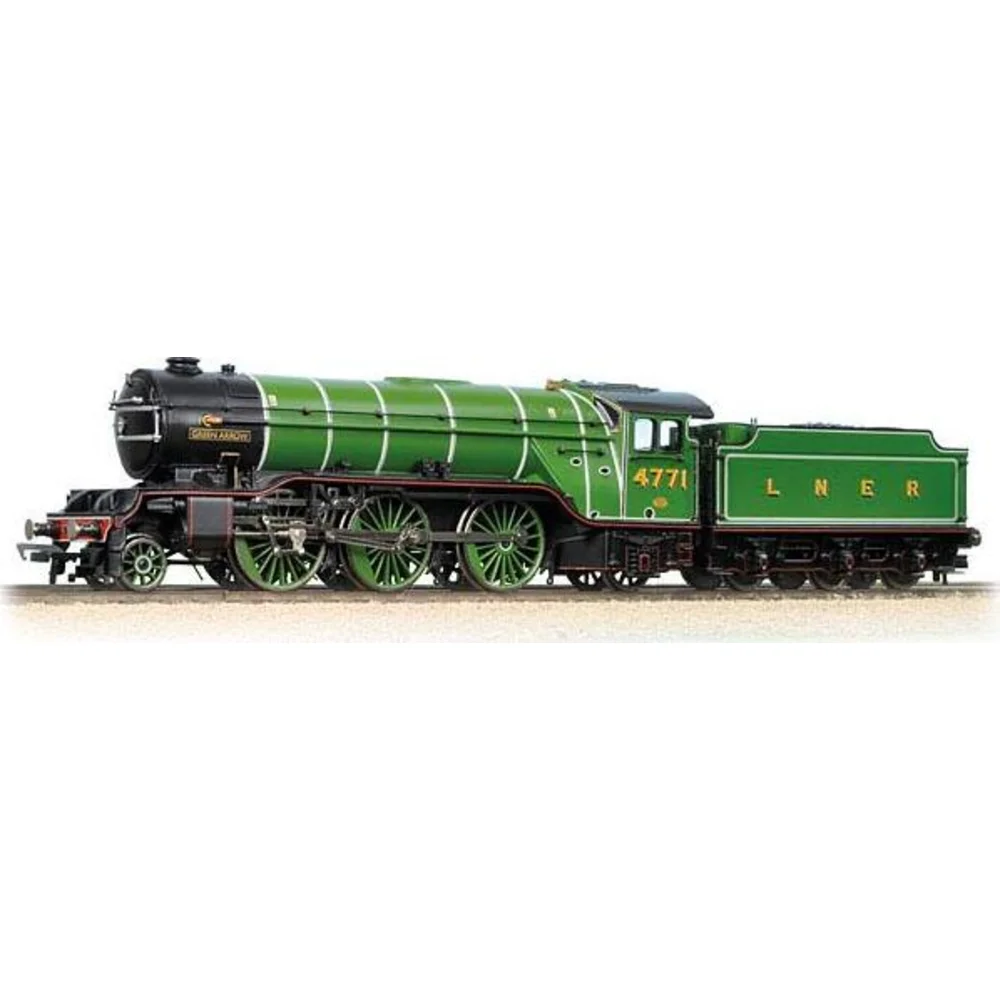Bachmann 31-550B
London & North Eastern Railway V2 4771 Green Arrow London & North Eastern Railway Lined Apple Green
Tooling
In 2012, Bachmann Branchline introduced a major upgrade to its OO gauge model of the LNER Class V2, replacing the original 1992 split-chassis tooling. This retooling aimed to deliver improved accuracy, reliability, and modern features such as DCC readiness, addressing long-standing criticisms of the earlier design. The V2, designed by Sir Nigel Gresley, was a mixed-traffic locomotive built between 1936 and 1944, and remains an iconic subject for British railway modellers.
Tooling Features
- Scale: OO gauge (1:76).
- Construction: Precision-moulded plastic bodyshell with a die-cast chassis for strength and weight.
- Detailing: Improved body proportions, separately fitted handrails, finer valve gear, detailed cab interior with glazing, and accurate tender variations.
- Couplings: NEM pockets with tension-lock couplers, replacing the fixed couplers of the earlier tooling.
Mechanical & Electrical
- Motor & Drive: Smooth-running can motor mounted in the chassis, driving the coupled wheels via a reliable gear train.
- Minimum Radius: Recommended for second radius curves (approx. 438 mm).
- Lighting: No factory lighting provided.
- Weighting: Die-cast chassis and internal metal components for improved traction.
DCC Capability
- DCC Ready with an 8-pin socket located in the tender.
- Space provided for a speaker to allow sound installation by the modeller.
Liveries Produced
The 2012 tooling was released in several authentic schemes, including:
- LNER Lined Green (Doncaster style)
- LNER Black
- BR Lined Black (early emblem)
- BR Green (late crest)
- Special editions such as preserved No. 4771 “Green Arrow”
Reviews & Commentary
At launch, the 2012 V2 was welcomed for its improved mechanism and DCC readiness compared to the split-chassis predecessor. However, some enthusiasts noted shortcomings in body shape accuracy, particularly around the firebox and smokebox, and commented on the relatively light weight affecting haulage. Online discussions and blogs highlighted that additional ballast could improve performance. Despite these criticisms, the model was considered a significant step forward and remained popular until the full retooling in 2021.
Interesting Notes
- The 2012 upgrade introduced a fixed Cartazzi rear axle design, improving stability over curves.
- Enthusiasts often added lead weight to enhance traction, a common modification discussed in forums.
Class & Prototype
- Class: London & North Eastern Railway V2
- Traction: Steam
- Built: 1936-1944
- Total Built: 184
- Running Number: 4771
- Name: Green Arrow
Operator & Livery
- Operator: London & North Eastern Railway
- Livery: Lined Apple Green
- Era: 9 - Privatisation
The London & North Eastern Railway emerged in 1923 as Britain's second-largest railway company, combining seven major railways including the Great Northern, North Eastern, and Great Eastern into a 6,590-mile network stretching from London's four terminals to the Scottish Highlands. Despite serving economically challenged industrial regions, the LNER achieved worldwide recognition for engineering excellence and speed records that remain unbroken today.
Under Chief Mechanical Engineers Sir Nigel Gresley, Edward Thompson, and Arthur Peppercorn, the LNER developed revolutionary locomotive designs characterised by three-cylinder layouts and streamlined aesthetics. Gresley's masterpieces included the A1 Pacifics featuring Flying Scotsman and the legendary A4 class, culminating in Mallard's world steam speed record of 126 mph in 1938.
The company pioneered luxury express services including the Silver Jubilee and Coronation streamliners, whilst investing in forward-thinking electrification schemes and massive marshalling yards. Notable achievements included operating the complete East Coast Main Line, introducing Britain's first regular 400-mile non-stop service, and commissioning Eric Gill's iconic typography that influenced railway design for decades.
Nationalised in 1948, LNER locomotives continued serving British Railways until the 1960s, with some A4 Pacifics working Scottish expresses until 1966. Today, the LNER's engineering legacy thrives through extensive preservation, new-build projects like Tornado, and comprehensive model ranges covering every major class in all popular scales, making LNER subjects essential for discerning railway modellers seeking authentic British steam-age atmosphere.
